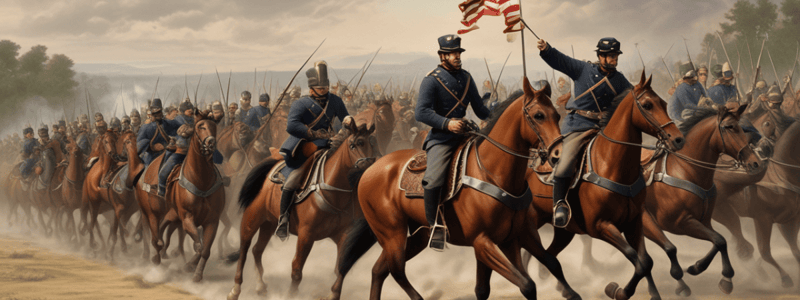Podcast
Questions and Answers
What was the primary reason for the agrarian South's economy being heavily dependent on slave labor?
What was the primary reason for the agrarian South's economy being heavily dependent on slave labor?
- The South's economy was heavily dependent on trade with Europe.
- The South's economy was heavily dependent on agriculture. (correct)
- The South's climate was not suitable for industrialization.
- The South had a shortage of white laborers.
What was the main point of contention between the North and South regarding states' rights?
What was the main point of contention between the North and South regarding states' rights?
- The right to maintain and expand slavery. (correct)
- The power to declare war.
- The regulation of trade.
- The distribution of federal funds.
What was the result of the Missouri Compromise, the Compromise of 1850, and the Kansas-Nebraska Act?
What was the result of the Missouri Compromise, the Compromise of 1850, and the Kansas-Nebraska Act?
- They ultimately led to the abolition of slavery.
- They led to the immediate secession of Southern states.
- They only provided temporary respite from the tensions. (correct)
- They provided a permanent solution to the sectional crisis.
What was the primary consequence of the failure to resolve the conflicts between the North and South?
What was the primary consequence of the failure to resolve the conflicts between the North and South?
What was the main difference between the economic systems of the North and South?
What was the main difference between the economic systems of the North and South?
What was the underlying cause of the sectionalism between the North and South?
What was the underlying cause of the sectionalism between the North and South?
What was the primary issue that the North and South could not reconcile?
What was the primary issue that the North and South could not reconcile?
What was the ultimate outcome of the attempts to resolve the conflicts between the North and South?
What was the ultimate outcome of the attempts to resolve the conflicts between the North and South?
Flashcards are hidden until you start studying
Study Notes
Social, Economic, and Political Tensions Leading to the Civil War
- The American Civil War was sparked by deep-seated social, economic, and political tensions between the North and South.
Key Issues Dividing the North and South
- Slavery:
- The agrarian South's economy heavily relied on slave labor.
- The industrializing North increasingly opposed the expansion of slavery.
- States' Rights:
- Southern states championed their right to maintain and expand slavery.
- This clashed with Northern demands for federal intervention to restrict slavery.
- Sectionalism:
- Each region prioritized its own economic interests and cultural values.
- This led to starkly different visions for America's future.
Failure of Compromises Leading to Secession and War
- Attempts to Resolve Conflicts:
- The Missouri Compromise, the Compromise of 1850, and the Kansas-Nebraska Act only provided temporary solutions.
- These compromises did not address the underlying issues, leading to heightened animosities.
- Secession of Southern States:
- The eventual secession of Southern states triggered the American Civil War.
Studying That Suits You
Use AI to generate personalized quizzes and flashcards to suit your learning preferences.




